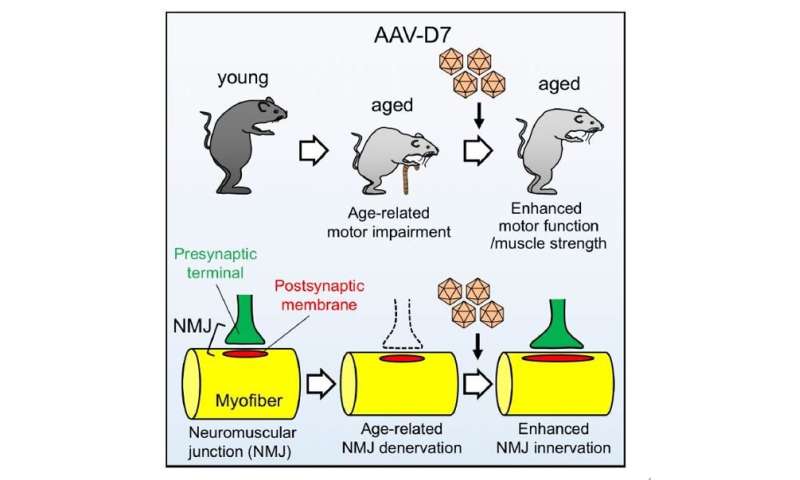
In an aging society, one of the most important and urgent tasks of scientific research is to counteract the decline in motor function and muscle weakness that accompanies the aging process.
A research group led by Professor Yuji Yamanashi of the Institute of Medical Science, the University of Tokyo, conducted experiments using aged mice to demonstrate that muscle denervation at the neuromuscular junction (NMJ) could be appreciably offset by an NMJ formation-enhancing treatment that strengthened the motor function and muscle of aged mice.
The results of this study suggest that NMJ formation-enhancing treatment may be effective to overcome motor impairment and muscle weakness associated with human aging.
The results of this research were published in iScience on August 5, 2020.
The NMJ is the only ‘bond’ that connects motor nerves to skeletal muscles
In order to move the body, precise control of skeletal muscle contraction via motor nerves is required. The NMJ is the only “bond” that connects motor nerves to skeletal muscles (the neuromuscular synapse), and its loss means that motor functions including breathing cease to work.
The research group focused on ‘nerve detachment’ aka ‘denervation’ at NMJs, in which the motor nerve becomes separated from the NMJ, a process that progresses with aging.
As a result of the treatment given to aged mice to enhance the formation of NMJs, the following three points were verified:
According to the research group, muscle denervation at the neuromuscular junction (NMJ), the essential synapse between motor neuron and skeletal muscle, is associated with age-related motor impairment. Therefore, improving muscle innervation at aged NMJs may be an effective therapeutic strategy for treating the impairment.
They previously demonstrated that the muscle protein Dok-7 plays an essential role in NMJ formation, and, indeed, its forced expression in muscle enlarges NMJs. Moreover, therapeutic administration of an adeno-associated virus vector encoding human Dok-7 (DOK7 gene therapy) suppressed muscle denervation and enhanced motor activity in a mouse model of amyotrophic lateral sclerosis (ALS). Here, they show that DOK7 gene therapy significantly enhances motor function and muscle strength together with NMJ innervation in aged mice.
Furthermore, the treated mice showed greatly increased compound muscle action potential (CMAP) amplitudes compared to the controls, suggesting enhanced NMJ transmission. Thus, therapies aimed at enhancing NMJ innervation have potential for treating age-related motor impairment.
For details of the research, please see the paper.
Possibility of opening the way to NMJ formation-enhancing therapy using compounds
Yuji Yamanashi, the corresponding author of this research, Professor at the Institute of Medical Science, The University of Tokyo, said, “In this new study with mice, NMJ augmentation treatment was shown to be effective for age-related motor impairment and muscle weakness, which are serious problems in an aging society. It has great social significance in terms of presenting the possibilities.”
In addition, this study is not only a basic study of gene therapy using AAV-D7, but also serves as a proof of principle for opening the way to NMJ formation-enhancing therapy using compounds.
Source: Read Full Article
